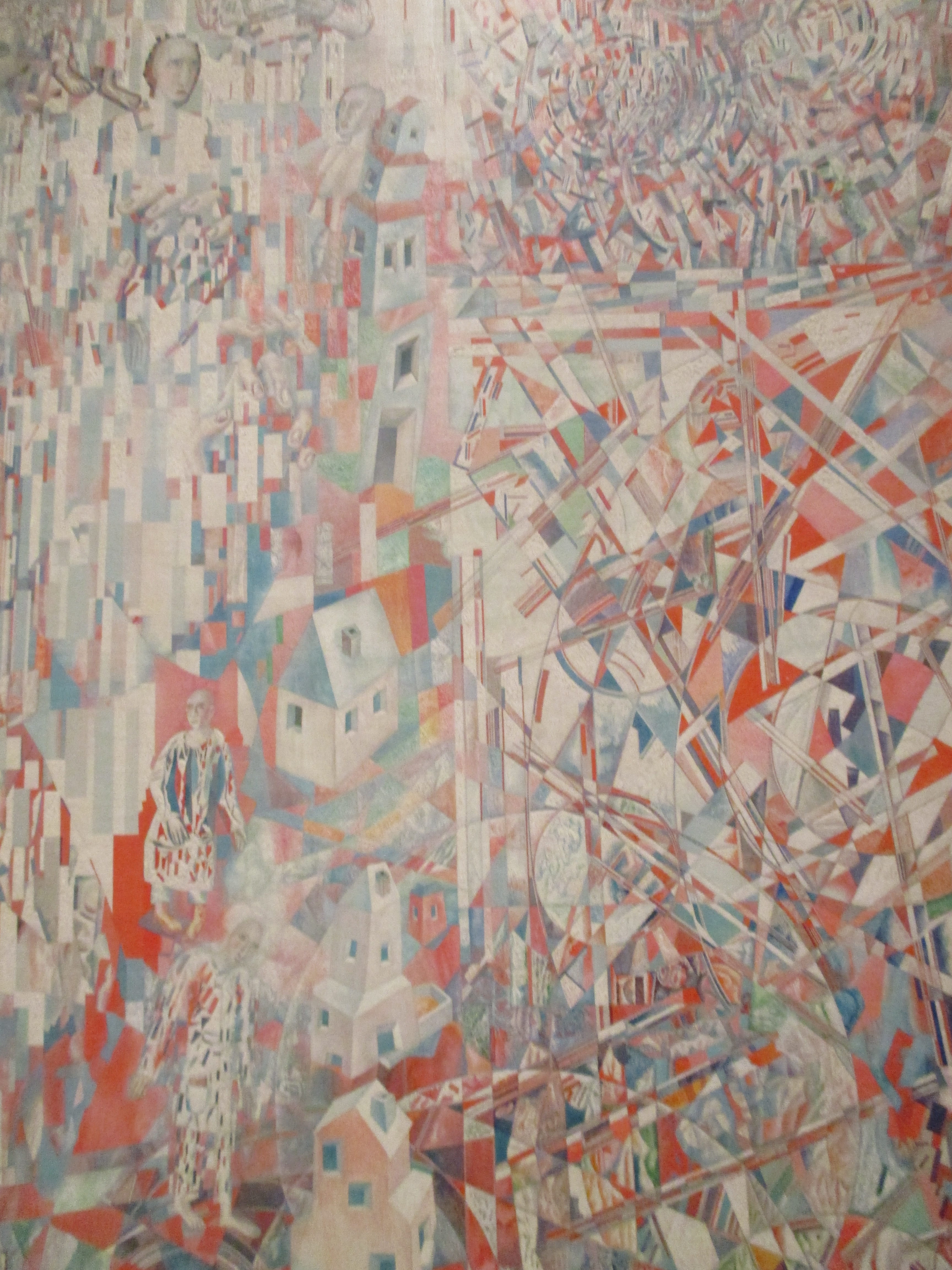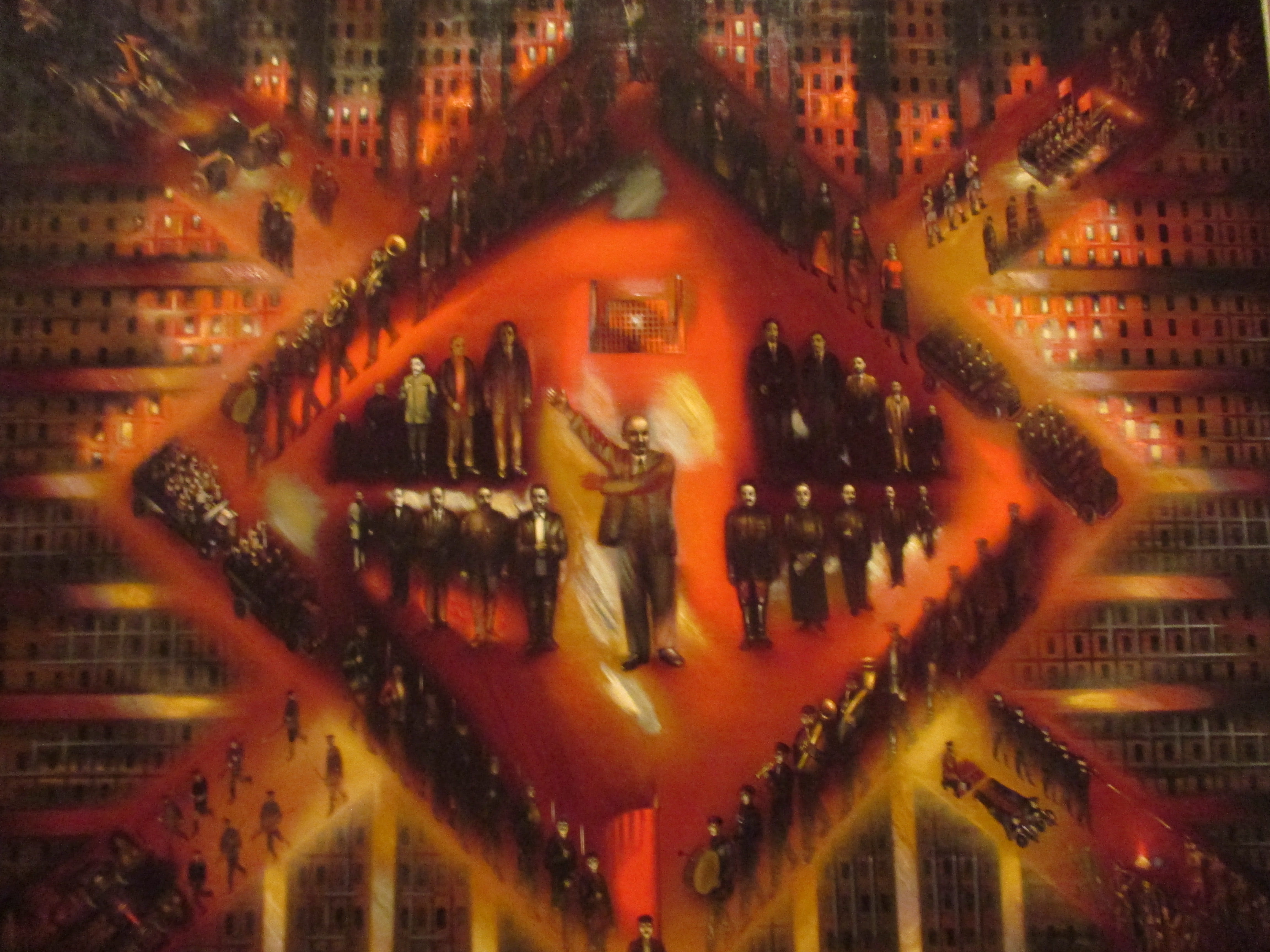by guest contributor Audrey Borowski
The imperial red hits you as soon as you enter the Royal Academy’s latest exhibition, “Revolution: Russian Art 1917-1932,” which sets out to explore the frenzy that gripped the Russian artistic scene between 1917 and 1932.
The artistic avant-garde initially enthusiastically extolled the ideals of the new Bolshevik regime. A new age had dawned on Russia, and its artists embraced their roles as apostles of this new vision. This exhibit explores the remarkable vitality and versatility of Russian art during that short but turbulent window, often presenting the viewers with lesser-known artists. From Isaak Brodsky’s studious portraits of its leaders Lenin and Stalin to Boris Kustodiev’s depiction of enthused masses, many artists set out to capture the euphoria that followed the revolution and the hope that it would be extended to the whole world.
At the heart of their endeavor lay the desire to create innovative paintings, sculptures, ceramics, crockery, textiles, and even architectural designs that would reach a mass, and for the most part illiterate, audience. New technologies were enlisted to convey these political messages and aestheticize the experience of the worker and peasant; through the magic of film and photography, the latter were refashioned as muscular heroic figures and Russia transfigured from a still overwhelmingly agricultural nation into a great industrial super-power. And whereas in the pictures, workers and peasants emerged liberated and sublimated, in reality, these machine-men and women were generally little more than slaves, dying of starvation in the name of communal collective agriculture. Reality, as this avant-garde movement would soon find out, fell dramatically short of its ideals.

Pavel Filonov, Formula of the Petrograd Proletariat, 1920-21 (State Russian Museum, St Petersburg)
Radical innovations had already been under way for a few years, but this artistic avant-garde seized the momentum of the revolution to precipitate change and formulate new art for a new world, exploring the full range of abstraction. In this era of radical experimentation, each artist developed his own particular visual language and vocabulary across a wide range of media. The painter Alexander Deineka deployed his characteristic use of geometric lines and collages of drawings, graphic images, and photo montages to convey workers’ dedication to the cause. Pavel Filonov’s method of “universal flowering” produced anguished phantasmagorias merging urban landscapes, heads, and geometric shapes in his “Formula for the Petrograd Proletariat.” Mikhail Matiushin projected pure cosmic teleology in his 1921 “Movement in Space.” Blok’s symbolist poetry greeted the revolution as a quasi-religious second coming. El Lissitzky designed new apartments for the new soviet lifestyle. The theatre director Vsevold Meyerhold designed biomechanics, a system in which emotions were experienced primarily through bodily movements and gestures. Vladimir Tatlin imagined flying gliders, Sergei Eisenstein recreated the revolution in his films, and Vassily Kandinsky conjured up symphonic abstract explosions.

Mikhail Mokh, State Porcelain Factory, Leningrad, tea set “Metal,” 1930 (The Petr Aven Collection)
The artist Kazimir Malevich took geometric abstraction to a whole new level with his invention of “suprematism” in 1915. Art, he thought, should first and foremost express spirituality, away from the “dead weight of the real world.” The Royal Academy’s exhibition recreates his display at the original 1932 exhibit in which he famously exposed “Black square,” the work he claimed marked the “zero point of art.” And yet, as artists were increasingly urged to depict social realities, the soviet man caught up in a dynamic vision of the cosmos soon began to give way to visions of faceless figures far removed from the utopian visions of cheery peasants laboring for the cause in the golden fields of collective farm labor that the Party extolled. As artists grew more ambivalent towards the regime, they started deploying their art to subvert its imagery.
A particularly striking and, for western viewers, unusual piece is “Insurrection” (1925) by Kliment Redko. In it, the painter has replaced Christ with Lenin, surrounded by his disciples in a diamond of fire that burns the city. The atmosphere of the painting is dark and infernal; the city has turned into prison. The revolution was slowly morphing into state repression. While the Revolution of 1917 had heralded a new age of hope and equality for most, repression had already started to kick in by 1921, with artistic freedom increasingly constrained in favor of the collective ideology.

Kliment Redko, Insurrection, 1925 (State Tretyakov Gallery, Moscow)
The exhibit not only showcases the gradual shift in power over the years, but also brings to the fore the inner contradictions of the age. In the face of extreme conditions and growing misery after the collapse of the economy and the urban infrastructure in the wake of the civil war, many artists looked back towards an idealized Russian past with its birch trees, snowed-under villages, troikas and countryside churches. They sought comfort in a world they felt had been lost forever before one that was failing to materialize, like Kuzma Petrov-Vodkin, a lesser-known painter who sought to discern the “optical magic” that coursed through reality. His pieces hark back to a more peaceful, curiously atemporal time, away from the tumult and prospect of hardship.
Over the years, the window for creativity and freedom of expression gradually narrowed, until Stalin decreed that socialist realism would be the only acceptable art form in the Soviet Union. 1932 simultaneously signaled the apex and the end of this artistic revolution; it was the year Nikolai Punin curated the exhibit “Fifteen Years of Artists of the Russian Soviet Republic” at the state Russian museum in then-Leningrad; it showcased more than two thousand works of art and has served as the inspiration for the present exhibition. That same year also sounded the final death knell of that era of dazzling creativity. Overnight, the Soviet state’s fittingly-named “People’s commissariat of Enlightenment” became the sole commissioner of art, and socialist realism the only acceptable art form. The soaring spirit of the avant-garde was brought to an abrupt halt.
While Lenin had envisaged art in mainly pragmatic terms as a tool of propaganda, Stalin had an acute understanding of the power of art and, with social realism, was intent on harnessing it towards the cultivation of his own legacy. His utopian vision celebrated physically perfect sportsmen and parading workers as the new heroes of this politically unified and collectivist vision. Art was to be in the image of regime: insipid, impersonal and soulless.
Disillusionment gradually set in. Mayakovsky shot himself in 1930; Meyerhold was executed in 1940; Punin died in a gulag in 1953. Many others would be purged in the following years.
Ultimately, the exhibit charts one of the human spirit’s greatest experiments in hope, as it first soared and was then violently repressed and crushed by a dream-turned-nightmare. Each piece documents a different facet of this human epic in striving and aspiration and bears testimony, in spite of mankind’s fragile memory and constant attempts to rewrite history, to the indomitable nature of the human spirit. That much is certain – and as I was walking away from the Royal Academy, Vladimir Mayakovsky’s fateful and all too timely words from 1921 continued to resonate in my ears:
“And since the crisis exists the world over—worldwide revolution is at their door—As clearly as two times two is four.”
Revolution: Russian Art 1917-1932 at the Royal Academy, London
Until 17 April
Audrey Borowski is a DPhil student in History of Ideas at the University of Oxford.



March 6, 2017 at 1:26 pm
This exhibit sounds incredibly powerful, and incredibly appropriate as an exhibition in a museum. I have been studying many of the prolific museum studies scholars for my exam in the last few weeks, and one of the major points of contention some have with museums is their inappropriate choice of what subject matter makes a good foundation for an exhibition. This one, as you describe it, seems to put objects at the center of the story, thus justifying the most effective dissemination of the related information in exhibition form. I hope to be able to visit it some day.